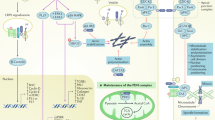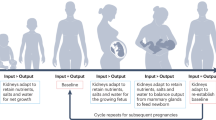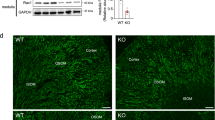Abstract
The kidney has an important role in the regulation of acid–base homeostasis. Renal ammonium production and excretion are essential for net acid excretion under basal conditions and during metabolic acidosis. Ammonium is secreted into the urine by the collecting duct, a distal nephron segment where ammonium transport is believed to occur by non-ionic NH3 diffusion coupled to H+ secretion. Here we show that this process is largely dependent on the Rhesus factor Rhcg. Mice lacking Rhcg have abnormal urinary acidification due to impaired ammonium excretion on acid loading—a feature of distal renal tubular acidosis. In vitro microperfused collecting ducts of Rhcg-/- acid-loaded mice show reduced apical permeability to NH3 and impaired transepithelial NH3 transport. Furthermore, Rhcg is localized in epididymal epithelial cells and is required for normal fertility and epididymal fluid pH. We anticipate a critical role for Rhcg in ammonium handling and pH homeostasis both in the kidney and the male reproductive tract.
This is a preview of subscription content, access via your institution
Access options
Subscribe to this journal
Receive 51 print issues and online access
$199.00 per year
only $3.90 per issue
Buy this article
- Purchase on Springer Link
- Instant access to full article PDF
Prices may be subject to local taxes which are calculated during checkout




Similar content being viewed by others
References
Butterworth, R. F. Hepatic encephalopathy. Alcohol Res. Health 27, 240–246 (2003)
DuBose, T. D., Good, D. W., Hamm, L. L. & Wall, S. M. Ammonium transport in the kidney: new physiological concepts and their clinical implications. J. Am. Soc. Nephrol. 1, 1193–1203 (1991)
Hamm, L. L. & Simon, E. E. Roles and mechanisms of urinary buffer excretion. Am. J. Physiol. 253, F595–F605 (1987)
Knepper, M. A. NH4 + transport in the kidney. Kidney Int. Suppl. 33S95–S102 (1991)
Weiner, I. D. & Hamm, L. L. Molecular mechanisms of renal ammonia transport. Annu. Rev. Physiol. 69, 317–340 (2007)
Pitts, R. F. The renal excretion of acid. Fed. Proc. 7, 418–426 (1948)
Sartorius, O. W., Roemmelt, J. C., Pitts, R. F., Calhoon, D. & Miner, P. The renal regulation of acid-base balance in man. IV. The nature of the renal compensations in ammonium chloride acidosis. J. Clin. Invest. 28, 423–439 (1949)
Rodriguez Soriano, J. Renal tubular acidosis: the clinical entity. J. Am. Soc. Nephrol. 13, 2160–2170 (2002)
Laing, C. M., Toye, A. M., Capasso, G. & Unwin, R. J. Renal tubular acidosis: developments in our understanding of the molecular basis. Int. J. Biochem. Cell Biol. 37, 1151–1161 (2005)
Marini, A. M., Vissers, S., Urrestarazu, A. & Andre, B. Cloning and expression of the MEP1 gene encoding an ammonium transporter in Saccharomyces cerevisiae . EMBO J. 13, 3456–3463 (1994)
Ninnemann, O., Jauniaux, J. C. & Frommer, W. B. Identification of a high affinity NH4 + transporter from plants. EMBO J. 13, 3464–3471 (1994)
Marini, A. M., Urrestarazu, A., Beauwens, R. & Andre, B. The Rh (rhesus) blood group polypeptides are related to NH4 + transporters. Trends Biochem. Sci. 22, 460–461 (1997)
Levine, P. & Stetson, R. E. An unusual case of intra-group agglutination. J. Am. Med. Assoc. 113, 126–127 (1939)
Le van Kim, C. et al. Molecular cloning and primary structure of the human blood group RhD polypeptide. Proc. Natl Acad. Sci. USA 89, 10925–10929 (1992)
Cherif-Zahar, B. et al. Organization of the gene (RHCE) encoding the human blood group RhCcEe antigens and characterization of the promoter region. Genomics 19, 68–74 (1994)
Ridgwell, K. et al. Isolation of cDNA clones for a 50 kDa glycoprotein of the human erythrocyte membrane associated with Rh (rhesus) blood-group antigen expression. Biochem. J. 287, 223–228 (1992)
Marini, A. M. et al. The human Rhesus-associated RhAG protein and a kidney homologue promote ammonium transport in yeast. Nature Genet. 26, 341–344 (2000)
Liu, Z. et al. Characterization of human RhCG and mouse Rhcg as novel nonerythroid Rh glycoprotein homologues predominantly expressed in kidney and testis. J. Biol. Chem. 275, 25641–25651 (2000)
Liu, Z., Peng, J., Mo, R., Hui, C. & Huang, C. H. Rh type B glycoprotein is a new member of the Rh superfamily and a putative ammonia transporter in mammals. J. Biol. Chem. 276, 1424–1433 (2001)
Quentin, F. et al. RhBG and RhCG, the putative ammonia transporters, are expressed in the same cells in the distal nephron. J. Am. Soc. Nephrol. 14, 545–554 (2003)
Verlander, J. W. et al. Localization of the ammonium transporter proteins RhBG and RhCG in mouse kidney. Am. J. Physiol. Renal Physiol. 284, F323–F337 (2003)
Eladari, D. et al. Expression of RhCG, a new putative NH3/NH4 + transporter, along the rat nephron. J. Am. Soc. Nephrol. 13, 1999–2008 (2002)
Bakouh, N. et al. NH3 is involved in the NH4 + transport induced by the functional expression of the human Rh C glycoprotein. J. Biol. Chem. 279, 15975–15983 (2004)
Benjelloun, F. et al. Expression of the human erythroid Rh glycoprotein (RhAG) enhances both NH3 and NH4 + transport in HeLa cells. Pflugers Arch. 450, 155–167 (2005)
Nakhoul, N. L. et al. Characteristics of renal Rhbg as an NH4 + transporter. Am. J. Physiol. Renal Physiol. 288, F170–F181 (2005)
Zidi-Yahiaoui, N. et al. Human Rhesus B and Rhesus C glycoproteins: properties of facilitated ammonium transport in recombinant kidney cells. Biochem. J. 391, 33–40 (2005)
Mak, D. O., Dang, B., Weiner, I. D., Foskett, J. K. & Westhoff, C. M. Characterization of ammonia transport by the kidney Rh glycoproteins RhBG and RhCG. Am. J. Physiol. Renal Physiol. 290, F297–F305 (2006)
Mayer, M. et al. Different transport mechanisms in plant and human AMT/Rh-type ammonium transporters. J. Gen. Physiol. 127, 133–144 (2006)
Westhoff, C. M., Ferreri-Jacobia, M., Mak, D. O. & Foskett, J. K. Identification of the erythrocyte Rh blood group glycoprotein as a mammalian ammonium transporter. J. Biol. Chem. 277, 12499–12502 (2002)
Chambrey, R. et al. Genetic ablation of Rhbg in the mouse does not impair renal ammonium excretion. Am. J. Physiol. Renal Physiol. 289, F1281–F1290 (2005)
Endeward, V., Cartron, J. P., Ripoche, P. & Gros, G. RhAG protein of the Rhesus complex is a CO2 channel in the human red cell membrane. FASEB J. 22, 64–73 (2008)
Soupene, E., Inwood, W. & Kustu, S. Lack of the Rhesus protein Rh1 impairs growth of the green alga Chlamydomonas reinhardtii at high CO2 . Proc. Natl Acad. Sci. USA 101, 7787–7792 (2004)
Ji, Q. et al. CeRh1 (rhr-1) is a dominant Rhesus gene essential for embryonic development and hypodermal function in Caenorhabditis elegans . Proc. Natl Acad. Sci. USA 103, 5881–5886 (2006)
Missner, A. et al. Carbon dioxide transport through membranes. J. Biol. Chem. 283, 25340–25347 (2008)
May, R. C., Kelly, R. A. & Mitch, W. E. Metabolic acidosis stimulates protein degradation in rat muscle by a glucocorticoid-dependent mechanism. J. Clin. Invest. 77, 614–621 (1986)
Bevensee, M. O. & Boron, W. F. Control of Intracellular pH (eds Alpern, R. J. & Hebert, S. C.) 1429–1490 (Elsevier Inc., 2008)
Pastor-Soler, N., Pietrement, C. & Breton, S. Role of acid/base transporters in the male reproductive tract and potential consequences of their malfunction. Physiology (Bethesda) 20, 417–428 (2005)
Karet, F. E. Inherited distal renal tubular acidosis. J. Am. Soc. Nephrol. 13, 2178–2184 (2002)
Kim, S. C. & Kim, H. W. Effects of nitrogenous components of urine on sperm motility: an in vitro study. Int. J. Androl. 21, 29–33 (1998)
van Straaten, H. W. et al. Cellular concentrations of glutamine synthetase in murine organs. Biochem. Cell Biol. 84, 215–231 (2006)
Acknowledgements
We are grateful to P. Drèze, B. André and P. Gabant for their contribution to the initial step of this study. We thank H. Mezdour, L. Pouilly and P. Persoons for microinjection experiments, B. Pajak for help in broad-spectrum histological assessment, V. Beaujean, Y. Cnops, H. Debaix and T. Nishino for excellent technical assistance, and A. Tamah and M.-F. Vincent for amino acid chromatography. These studies were supported by the Belgian agencies FNRS and FRSM (3.4.546.04.F, 3.4.635.05.F, 3.4592.06.F), the ‘Fonds Brachet-recherche’, the ‘Fonds Van Buuren’, the ‘Fondation Alphonse & Jean Forton’, a Concerted Research Action (05/10-328), an Inter-university Attraction Pole (IUAP P6/05), the Swiss National Science Foundation (31-109677), an INSERM grant, and the EuReGene and EUNEFRON (GA#201590) projects of the European Community (FP6 and FP7). S.Bi. was the recipient of a FRIA fellowship; H.B., A.M.M. and C.S. are Research fellow, Research associate and Research director of the FNRS, respectively.
Author Contributions S.Bi., J.S., C.S. and A.M.M. developed the concept of this study; all authors contributed to the intellectual design, execution and interpretation of the experiments; S.Bi. and A.M.M. wrote the paper with specific contribution of all authors and the particular involvement of O.D. and C.A.W. All authors analysed and discussed the data, and commented on the final version of the manuscript. S.Bi., H.B. and S.Bo. share first authorship.
Author information
Authors and Affiliations
Corresponding author
Supplementary information
Supplementary Information
This file contains Supplementary Methods, Supplementary References, Supplementary Figures 1-3 with Legends and Supplementary Tables 1-6 (PDF 553 kb)
Rights and permissions
About this article
Cite this article
Biver, S., Belge, H., Bourgeois, S. et al. A role for Rhesus factor Rhcg in renal ammonium excretion and male fertility. Nature 456, 339–343 (2008). https://doi.org/10.1038/nature07518
Received:
Accepted:
Issue Date:
DOI: https://doi.org/10.1038/nature07518
This article is cited by
-
Metabolic acidosis in chronic kidney disease: mere consequence or also culprit?
Pflügers Archiv - European Journal of Physiology (2024)
-
State of knowledge on ammonia handling by the kidney
Pflügers Archiv - European Journal of Physiology (2024)
-
The pathophysiology of distal renal tubular acidosis
Nature Reviews Nephrology (2023)
-
PIN5 is involved in regulating NH4+ efflux and primary root growth under high-ammonium stress via mediating intracellular auxin transport
Plant and Soil (2023)
-
Kidney metabolism and acid–base control: back to the basics
Pflügers Archiv - European Journal of Physiology (2022)
Comments
By submitting a comment you agree to abide by our Terms and Community Guidelines. If you find something abusive or that does not comply with our terms or guidelines please flag it as inappropriate.



